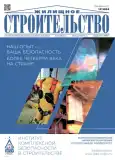Метод расчета исходных данных для определения водонепроницаемости светопрозрачных конструкций на базе метеорологических наблюдений
- Авторы: Траоре А.С.1, Константинов А.П.1, Аксёнов И.С.1
-
Учреждения:
- Национальный исследовательский Московский государственный строительный университет
- Выпуск: № 12 (2024)
- Страницы: 3-7
- Раздел: СТАТЬИ
- URL: https://gynecology.orscience.ru/0044-4472/article/view/646376
- DOI: https://doi.org/10.31659/0044-4472-2024-12-3-7
- ID: 646376
Цитировать
Полный текст
Аннотация
Нормативный предел водопроницаемости светопрозрачных ограждающих конструкций в России и методы лабораторных испытаний водопроницаемости в настоящее время не привязаны к условиям строительства (климатическим параметрам региона строительства, высоте здания и пр.). В данной работе предлагается метод расчета исходных данных для оценки водонепроницаемости светопрозрачных конструкций с учетом условий строительства (климатического региона строительства, высоты установки конструкции). Данный метод базируется на применении стандартных данных многолетних метеорологических наблюдений о количестве горизонтальных осадков и скорости ветра во время дождя. Данный метод расчета предлагается использовать при обосновании проектных требований к водонепроницаемости светопрозрачных конструкций, а также при проведении их лабораторных испытаний. Использование данного метода возможно только при наличии многолетних данных метеонаблюдений за количеством горизонтальных осадков и скорости ветра во время дождя, которые доступны не для всех климатических регионов.
Ключевые слова
Полный текст
Об авторах
А. С. Траоре
Национальный исследовательский Московский государственный строительный университет
Автор, ответственный за переписку.
Email: sikart37@gmail.com
аспирант
Россия, 129337, г. Москва, Ярославское ш., 26А. П. Константинов
Национальный исследовательский Московский государственный строительный университет
Email: apkonst@yandex.ru
канд. техн. наук
Россия, 129337, г. Москва, Ярославское ш., 26И. С. Аксёнов
Национальный исследовательский Московский государственный строительный университет
Email: ivanak1995@mail.ru
канд. техн. наук
Россия, 129337, г. Москва, Ярославское ш., 26Список литературы
- Bossche N.V.D. Watertightness of Building Components: Principles, Testing and Design Guidelines. Stedenbouw: Universiteit Gent. 2013. January. 297 р.
- Lacy R.E. Driving-rain maps and the onslaught of rain on buildings. RILEM/CIB Symp. On Moisture Problems in Buildings, Rain Penetration, Helsinki. 1965. August 16–19. Vol. 3, pp. 3–4.
- Straube J.F. and Burnett, E.F.P. Simplified prediction of driving rain deposition. Proc of International Building Physics Conference, Eindhoven. 2000, September 18–21, pp. 375–382.
- Best A.C. 1950. The size distribution of raindrops. Quarterly Journal of the Royal Meteorological Society. 1950. Vol. 76, pp. 16–36. http://dx.doi.org/10.1002/qj.49707632704
- Dingle A.N. and Lee Y. Terminal Fallspeeds of Raindrops. The Journal of Applied Meteorology and Climatology. 1972. August. Vol. 11, pp. 877–879.
- Богданова Э.Г. Методика расчета сумм осадков, проходящих через вертикальное сечение // Труды Главной геофизической обсерватории им. А.И. Воейкова. 1975. Вып. 341. С. 79–87. Bogdanova E.G. Methodology for calculating precipitation amounts passing through a vertical section. Trudy Glavnoy Geophysicheskoy Observatorii im. A.I. Voeikova. 1975. Iss. 341, pp. 79–87. (In Russian).
- Иванова Е.В. Специализированные характеристики интенсивности осадков для прикладных целей: Дис. … канд. геогр. наук. СПб., 2011. 112 с. Ivanova E.V. Specialized characteristics of precipitation intensity for applied purposes. Cand. Diss. (Geography). Saint Petersburg. 2011. 112 p. (In Russian).
- Linsley R.K., Kohler M.A., Paulhus J.L.H. Applied Hydrology. McGraw-Hill, New York, US. 1975.
Дополнительные файлы






